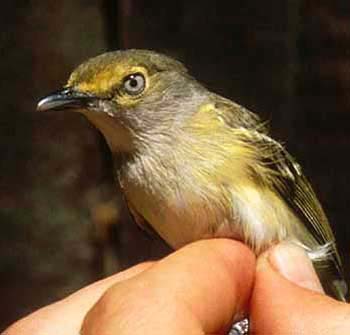 WHITE-EYED
VIREO Vireo griseus WHITE-EYED
VIREO Vireo griseus
24 May 2000 at Big Sur River mouth, MTY, California
Today Jim Booker and BSOL interns Eddie Price, Stacy Scott, and Jason
Scott discovered this vireo singing at the Big Sur R. mouth in Andrew Molera
State Park. It was frequenting a large & dense patch of willows with
thick poison oak understory west of the outhouse where one enters the “headlands
patch” on the north side of the river mouth itself. It was usually by itself
although occasionally it interacted with a family of Wrentits in that same
patch. The afternoon was unusually calm for spring, and there was a dense
fog layer on the coast.
Jim called me at 2:30 p.m. and (after alerting others,
mostly by leaving a host of messages on answering machines) I arrived at
3:30 pm. Jim and the interns were still with the bird which was singing
in the dense thickets as I walked up. They then left, and I spent an hour
with the bird, seeing it well (but briefly) twice during the next hour.
It sang much of the time between 5-10 minute intervals without singing.
It gave a wide variety of vocalizations, including a fairly standard staccato
“chip-per-wee-o-check!” song, then switched to a loud “pic! - ker-chee”
song, a “ker-chee, ker-chee, chick!” song, various versions of the loud
sharp “pic!” note (like a very sharp Hairy Woodpecker) followed by a antshrike
fast “hahahahaha” trill, a “Ker!” note followed by a downscale dry flat
trill (Jim thought “spadebill-like”), a rising & falling “wheeer” note
(copied vocally by one of the wrentits), and a fairly standard vireo chatter.
Description: a small, very active, bright & contrasty gray-headed
yellow-flanked little bird. Smaller than adjacent Wrentits (and much shorter-tailed)
and more lithe than a fledgling Song Sparrow nearby. It was always restless
and moved substantial distances unexpectedly (and out of ear-shot) over
a several hundred yard area. I had excellent (but brief) views with 8X
binoculars as it came close to the trail and worked up into the 8-10 canopy
of trail edge willows, or nervously bounced about a more open poison-oak
patch, sitting up on bare twigs several times. It was a small vireo, sometimes
cocking a comparatively short tail, with comparatively heavy bill (with
a distinct hook --vireo-like -- at the tip). My eye was immediately drawn
to a medium-gray head that set off yellow “spectacles” (eye-ring and loral
stripe that seems to meet over the bill) and a white throat, giving a “colorful”
look to the head. I could see a white eye with dark pupil. The gray extended
across the crown and nape, and contrasted with greenish back. Underparts
white except for bright yellow flanks, which are themselves nicely set
off from black wings. Two reasonably broad white wingbars cross the black
upperwing coverts (tips of greater & median coverts). Didn't note the
color of rump, tail (non-contrasting color -- either greenish or
dark), or legs.
I saw the bird sing a couple times but mostly I just listened
to it giving the variations detailed in the opening paragraphs. A pair
of Wrentits were nearby for part of the time, and they seemed to be vocally
copying the “wheeer” notes (and maybe others... Price told me he thought
the Wrentits were doing some of the song.... but I never felt they did).
This is the 2nd record for MTY; the first was banded by BSOL here at
the Big Sur R. mouth 4 June 1994 but never seen again.
— Don Roberson, Pacific Grove CA
Addenda: we learned later that Nancy McMahon had a bird singing
in this exact spot on 20 May that she could not identify; she returned
the next weekend and confirmed that what she had heard was the song of
this White-eyed Vireo. Thus it has been here since 20 May but not identified
until 23 May. The bird remained in this exact same patch through 17 June;
I saw or heard it several more times. It had a well defined territory within
the patch and could be heard singing at its various song posts along the
boundary.
On 12 June, Booker caught a White-eyed Vireo in the BSOL
nets a mile upstream and banded and released it. It was sexed in-hand as
a female [no cloacal protuberance]. The next time Booker was down at the
"headlands" he paid special attention to see the legs of this singing White-eyed
Vireo — it was unbanded. Therefore we have two separate reasons to be sure
that the 12 June bird was a different individual than this territorial
male.
|
 White-eyed
Vireo is a rare vagrant to Monterey County. All five records to date have
been in May-June and all have been at the Big Sur R. mouth. This photo
(right) is of the first MTY record on 4 June 1994. The May-June pattern
is consistent with most of the other ~40 records of this vagrant in California;
there are only a handful of fall records in October and a couple summering
individuals. Twelve of the State's total occurred during a single incursion
in spring 1992, but all MTY records were later.
White-eyed
Vireo is a rare vagrant to Monterey County. All five records to date have
been in May-June and all have been at the Big Sur R. mouth. This photo
(right) is of the first MTY record on 4 June 1994. The May-June pattern
is consistent with most of the other ~40 records of this vagrant in California;
there are only a handful of fall records in October and a couple summering
individuals. Twelve of the State's total occurred during a single incursion
in spring 1992, but all MTY records were later.
 WHITE-EYED
VIREO Vireo griseus
WHITE-EYED
VIREO Vireo griseus